Legion of Honor Collection
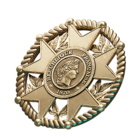
"For about a hundred years, plaques with the following words—Honor, Motherland, Bravery, Discipline—inscribed on them could be seen affixed to the gun turrets and superstructures of the French Navy's ships. This motto of the Republic's Navy was coined by fusing the mottos of two of the country's oldest military decorations—the Legion of Honor order of merit and the Military Medal.
To honor France's rich naval history, her remarkable ships, and significant awards, we're launching a new collection called "Legion of Honor"."
The overall collection comprises four sub-collections. Each sub-collection grants a different reward, and there is a reward for for obtaining all 16 items. Duplicates can be exchanged at a 5:1 ratio.
Contents
Sub-Collections
Ships
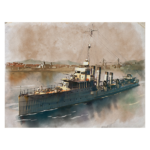
At the beginning of the 20th century, the entire French naval shipbuilding industry went all out to commission as many battleships and armored cruisers into the Navy as it could. As a result, the Republic's Navy entered World War I with practically no light forces in their service. The only destroyers it had were too weak and scarce in number.
Among the largest French destroyers that entered service after the war had already broken out were Enseigne Roux-class ships. The only armament they carried were several 100 and 65 mm guns coupled with two single-tube torpedo launchers. The third ship in the series was Enseigne Gabolde, which was completed only in 1923 under a design altered to draw on the experience gained during the war. The destroyer turned out to significantly outgun her former sister ships. Enseigne Gabolde's main battery guns were turned into dual-purpose ones, comprising three 100 mm guns. Another alteration was to equip this destroyer with twin-tube torpedo launchers. The ship was named after ship-of-the-line ensign Jean Gabolde, who died in 1911 in an explosion that destroyed battleship Liberté.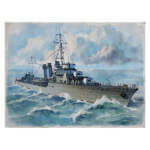
Laid down between 1922–1923, six Jaguar-class large destroyers and 12 Bourrasque-class destroyers represented a giant leap forward for the development of the torpedo boat-type ships in the French Navy. Even relatively small "Bourrasques" were almost double the size of their prewar predecessors. The use of 130 mm guns on series-produced destroyers in the 1920's was an extraordinary solution, too. The 12 ships were named after various winds and other weather activities—Cyclone ("Cyclone"), Ouragan ("Hurricane"), and Tornade ("Tornado") to name a few. In French and a number of other languages, the word "bourrasque" is used to mean a sharp gust of cold wind that is often aggravated by rain, hail, or snow.
By the time that World War II broke out, Bourrasque-class destroyers were already relatively outdated, yet they were still used extensively. Four destroyers were sunk during the defense of the northern coast of France between May–June 1940, including Siroco, and the lead ship Bourrasque which was lost off the coast of Dunkirk. Three more ships of the series perished during the Allied landings in North Africa in November 1942. After a brief period of service in the Italian Navy, destroyer Trombe, which had earlier survived a flooding in Toulon, saw action in battles with German ships in the Mediterranean in 1945.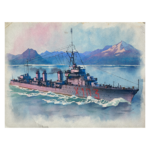
A further development of the post-war Jaguar-class large destroyers, six Guépard-class ships entered service between 1929–1931. Armed with 139 mm guns, they perfectly lined up with the "destroyer hunter" concept of the ship type. It must be said, though, that an encounter with any "Guépards" could turn into a dangerous adventure, even for the Italian light cruisers with thin armor that were built during the late 1920s and early 1930s.
Guépard-class large destroyers were followed by two more series of ships with similar characteristics. These were the Aigle-and Vauquelin-class ships, which retained the sleek four-smock-stack design of their prototype. All the "Guépards" saw service in various theaters of World War II: in the North Sea, the Mediterranean, and off the Atlantic coast of Africa. One of them was lost during the Norwegian campaign in May 1940; the rest were scuttled in Toulon in November 1942, so as to not fall into the hands of the Nazis.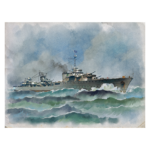
Six "Le Fantasque"-class ("Capricious") large destroyers were commissioned in 1936. Large in size, well-armed, and extremely fast, they could catch up to and send any enemy destroyer to the depths of the sea. Ships of the "Le Fantasque" class were dangerous because, unlike foreign “destroyer flotilla destroyers,” the French contre-torpilleurs were intended for operations within formations, i.e. in squadrons of six ships or divisions of three ships.
In the early stages of World War II, Le Fantasque-class large destroyers were used to hunt down German raiders and blockade runners in the Atlantic off the African coast. After the summer of 1940, Le Triomphant, under the command of Philippe Auboyneau, emerged as the most battle-worthy operational large ship of the Free French Naval Forces. For a long time, she had perhaps been the only warship with the tricolor of the Republic operating in the Pacific. In 1943, the Le Fantasque-class ships that remained in commission were reclassified as "light cruisers." Assigned to the same division, Le Fantasque, Le Terrible, and Le Malin continued to operate in the Mediterranean until the end of the war, destroying German light ships and boats.Reward
Completing this sub-collection provides the following reward:
| Patch | Name |
|---|---|

|
Camouflage Color Scheme - Custom color schemes for the camouflages of all French Battleships. |
Order of the Legion of Honor

The Grand Cross, the highest class of the National Order of the Legion of Honor, was established by Napoleon Bonaparte in 1805, several years after the Order itself had been introduced. Initially, however, it was designated as a "grand badge," "grand ribbon," or "grand eagle," the latter stemming from the fact that, at the time of Napoleon, an Imperial eagle was depicted above the star of the Order. With the founding of the Third French Republic in 1870, a profile of Marianne, the symbol of the Republic, took its place on the obverse side of all insignia of the Legion of Honor.
Apart from the gilded star displayed on their right breast, a person awarded with the highest class of the Order was to wear the Grand Cross affixed to a broad red sash worn over the right shoulder. The reverse side of the cross depicted the motto of the Order—"Honneur et Patrie" ("Honor and Fatherland").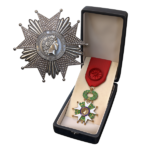
In order of importance, the next class of the Order of the Legion of Honor, that immediately precedes the highest class ("Grand Cross") is the "Grand Officier" class ("Grand Officer"). The Grand Officer insignia comprises a large silver star displayed on the right breast and the Cross of the Order worn on the left breast, suspended from a red silk ribbon with a rosette. In the center of both the star and the cross, is a round medallion depicting, from the times of the Third Republic, the profile of Marianne and the inscription "République Française" ("French Republic"). In 1946, after World War II came to an end, the formation of the Fourth Republic was announced, and the establishment date of the Third Republic (1870) was no longer indicated on the insignia of the Order.
The famous seamen who joined the list of the “Grand Officers” of the Legion of Honor included Admiral Amedey Courbet, one of the heroes of the Franco-Chinese war of 1884–1885, and Vice Admiral Émile Muselier, the first commander of the Free French Naval Forces. In 1940, the latter proposed adopting the Cross of Lorraine as a symbol of the never-ending struggle of the French against the Nazis.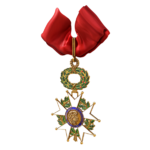
In 1816, membership of the Order of the Legion of Honor took on a form that continues to exist to this very day. The lowest distinction degree is referred to as "Knight." It is followed by "Officer," then "Commander," then "Grand Officer," and finally, "Grand Cross." Each of the degrees gave the right to wear a special form of the Order badge with five forked rays, covered in white enamel. The badge of the Commander was a little larger than the others, inferior in size only to the Grand Cross. It was worn around the neck, suspended from a red ribbon necklet.
Throughout the history of the Order, most of its recipients were from the military. Since, with rare exceptions, it was impossible to bypass the junior degrees of the Order to receive the highest, a naval officer could climb to the degree of being Commander of the Order of the Legion of Honor only when already at the rank of Admiral. One of the most famous civilian recipients of the degree of Commander was the outstanding shipbuilder, Émile Bertin, whose influence on the appearance of cruisers as a type of ship at the end of the 19th century can't be underestimated. Hit projects were brought to life through dozens of ships built for the needs of not only the French Navy, but the Japanese Navy as well (in the years of its early development).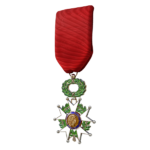
During the Great French Revolution at the end of the 18th century, all the awards and orders that existed at the time were abolished. However, the young Republic constantly waged wars, and its armed forces needed a reward system to maintain martial ardor. In 1802, on the initiative of Napoleon Bonaparte, the Order of the Legion of Honor was instituted with reference to the knightly orders of the past, and initially conceived as an association of the best and most-honored citizens.
The Order had four (later five) levels of distinction. Initially, the lowest degree was called "Legionnaire." In 1808, it received its present-day name, "Chevalier" ("Knight"). The outward appearance of the badges of the Order has undergone several changes throughout its history. Only its main element has remained constant: a five-armed "Maltese Asterisk," which gave the Order of the Legion of Honor its distinctive and easily recognizable style.Reward
Completing this sub-collection provides the following reward:
| Patch | Name |
|---|---|

|
Camouflage Color Scheme - Custom color schemes for the camouflages of all French Cruisers. |
Military Decorations of France
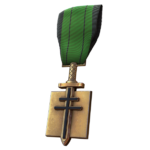
The "Ordre de la Libération" ("Order of Liberation")—the second highest Order of the French Republic—was established in November 1940 by General de Gaulle, who headed the Free France movement. The obverse side of the medal of the Order depicted a gladius sword and a Cross of Lorraine, the symbol of the Resistance forces. The reverse side displayed a relief inscription of the motto of the Resistance: "Patriam Servando Victoriam Tulit" ("By Serving the Fatherland, He/She Achieved Victory").
The Order was bestowed to people of the military and civilian communities, including foreign nationals, for exceptionally distinguished deeds in the liberation of France. The statute of the award gave it features which were typical of ancient orders of knights, and de Gaulle believed recipients of the Order, called "Compagnons de la Libération" ("Companions of Liberation") to be the new "Crusaders." In 1946, the Order ceased to be awarded because "the objective of the Resistance had been achieved." Later, as special exceptions, the Order was awarded again twice: to honor Winston Churchill and the British monarch, George VI. All in all, there were a little over a thousand Companions of the Order, including those awarded posthumously. Among them was Admiral Philippe Auboyneau, one of the leaders of the Free French Naval Forces.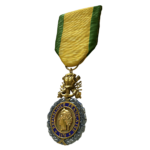
First established in 1852, the "Médaille militaire" ("Military Medal") is one of the highest military decorations of France. Since 1870, the obverse side of the medal has borne the left profile of Marianne being the national personification of the French Republic. The reverse of the medal is common to all variants since inception of the award, and bears the relief inscription "Valeur et Displine" ("Valor and Discipline").
The medal is awarded to members of the military other than commissioned officers for acts of bravery in action, being inferior in precedence only to the Order of the Legion of Honor. On special occasions, it can be awarded to generals and admirals who have been commanders-in-chief as a supreme award for leadership. During World War II, the Military Medal was bestowed upon Admiral Georges Thierry d'Argenlieu, one of the major personalities of the Free French Naval Forces, who had a record that included several battles that he participated in personally.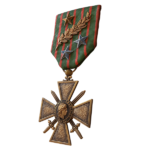
Shortly after the outbreak of World War I, French military circles stepped forward with a proposal to establish a new award. The Order of the Legion of Honor and the Military Medal continued to be granted relatively rarely, while hostilities at that time had risen to an unprecedented scale. The valorous service of thousands of officers, soldiers, and seamen needed to be somehow recognized. It was for this purpose that the "Croix de Guerre" ("Military Cross") was established in April 1915.
The award was given both to servicemen and civilians whose deeds of valor committed during the war were personally cited in official reports. At the same time, depending on the level from which the report came (division, squadron, fleet), a special sign in the form of a five-pointed star or a palm branch made from a particular metal was attached to the ribbon of the order. Subsequent actions worthy of citations were limited to additional ribbon devices to be affixed to the originally received insignia. Thus, Vice-Admiral Émile Guépratte, who had had three citations in the reports of the Navy's Commander, had three palm branches augmenting his Military Cross.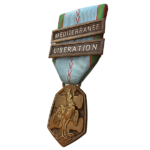
The 1939–1945 Commemorative War Medal (French: "Médaille commémorative de la guerre 1939–1945") is a commemorative medal of France established in 1946 and awarded to all soldiers serving under French authority or under a French government in a state of war against the Axis nations, including members of the French resistance. The medal was struck from bronze. Its obverse bore the relief image of a rooster superimposed onto a Cross of Lorraine, the symbol of Free France, with its wings spread and standing on a broken chain.
The medal hung from a silk moiré ribbon with a vertical series of red "V" letters denoting victory in the war. Special clasps could be attached to the ribbon to denote operational theaters or military campaigns of the recipient. Soldiers of the Resistance, as well as those who had taken part in the liberation of Corsica and the in the French Campaign between 1943 and 1945, wore a clasp with the word "Liberation" (French: "Libération") inscribed on it.Reward
Completing this sub-collection provides the following reward:
| Icon | Details |
|---|---|

|
Second Flag - Ability to mount a second flag on all French Battleships. |
Badges
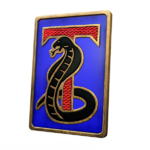
Large destroyer Le Terrible was launched in November 1933 in Caen (department of Calvados, Normandy region). During sea trials, all of her Le Fantasque-class sister ships exceeded a speed of 40 knots. However, Le Terrible emerged victorious in this race, having sustained a speed of 45 knots, an unsurpassed speed record for a large surface ship. According to a tradition adopted in the French armed forces, everyone who served on a ship after her commissioning ordered badges with her emblem. Le Terrible's emblem depicted a black cobra encircling a red letter "T".
During World War II, Le Terrible had a rich operational record. In the autumn of 1939, she participated in the hunt for German commerce raiders in the Atlantic as she intercepted and sank the blockade runner Santa Fe. After an upgrade in the United States in 1943, Le Terrible saw action off the coast of Italy, took part in the liberation of Corsica, supported the landings in the south of France, and countered hostile shipping in the Adriatic.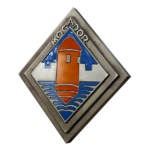
The finest of the French large destroyers. The most powerful representatives of this type of ship were Mogador and Volta. By their dimensions (a length exceeding 137 meters) and fire power (eight 139 mm guns), ships of this type were almost closer to light cruisers, yet far outmatching them in terms of speed. The lead ship, Mogador, named after the French-African Morocco port city, entered service in June 1938. Military defense constructions built in Mogador in the 18th century served as the basis for the ship's badge.
Created for actions alongside high-speed battleships of the Dunkerque class, at the beginning of World War II Mogador and Volta joined them as part of the Raiding Force (French: "Force de raid"). Right up until the fall of France, both ships had seen active service in the Atlantic, in the Northern Sea and in the Mediterranean. In July 1940, after the Vichy regime was established in France, the British fleet attacked French ships at the base at Mers-el-Kébir. During the attack, Mogador was hit by a 381 mm British shell and sustained severe damage, putting her out of action for quite a time. In November 1942, Mogador was scuttled in Toulon Harbor to keep her from falling into German hands.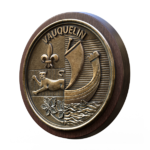
French naval officer Jean Vauquelin made a name for himself during battles against the English off the coast of Canada during the Seven Years' War (1756–1763). In June 1758, he successfully evaded the Royal Navy's blockade of Louisbourg twice. Those exploits of his were subsequently recognized by the French and British alike. In May 1760, while escorting a fleet of transport ships, Vauquelin, who commanded a small frigate, was pursued by a British squadron led by the 74-gun ship-of-the-line, Vanguard. During the 2-hour gallant fight that followed, the frigate fired all of her ammunition. The ship was almost burnt to ashes, and her defiant commander was taken prisoner. However, in a tribute to Vauquelin's valor and dedication, the British soon released him to become a national hero of France, and subsequently of French-speaking Canada.
In September 1932, a large destroyer designated "Vauquelin" was launched in the city of Dunkirk in northern France. The ship's badge is based on the coat of arms of the Canadian province of Quebec, the region that Jean Vauquelin defended and on which he left his mark in history.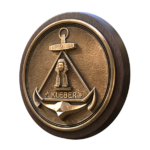
In 1939, France commenced work on the design of "3,000-ton scout ships," intending to further build upon the concept of the Mogador-class large destroyers. The plan provided for as many as four of such ships to be constructed. The new warships were supposed to join Mogador and Volta to make up a full squadron of six ships. At the beginning of the war with Germany, the new large destroyers were named after the generals of the Great French Revolution who rose to fame in battles against the Germans and Austrians: Kléber, Marceau, Hoche, and Desaix.
All four—Jean-Baptiste Kléber, François Séverin Marceau, Lazare Hoche, and Louis Charles Antoine Desaix—knew each other well enough, as at various times they had fought side by side. Marceau received a fatal wound in 1796 in a battle against the Austrians. Hoche, a good friend of his, died one year later. On June 14, 1800, on the same day that an Austrian bullet struck General Desaix during the battle of Marengo in Italy, Kléber, who was in command of the Egyptian army, was assassinated in Cairo. After nearly 140 years, in April 1940, the shipyards at Dunkirk, Nantes, and Lorient received an order for the construction of four ships with their sides adorned with the names of these glorious commanders.Reward
Completing this sub-collection provides the following reward:
| Icon | Details |
|---|---|

|
Second Flag - Ability to mount a second flag on all French Cruisers. |
Overall Reward
Completing the entire collection provides the following rewards:
| Icon | Details |
|---|---|

|
Second Flag - Ability to mount a second flag on all French Destroyers. |

|
Camouflage Color Scheme - Custom color schemes for the camouflages of all French destroyers. |